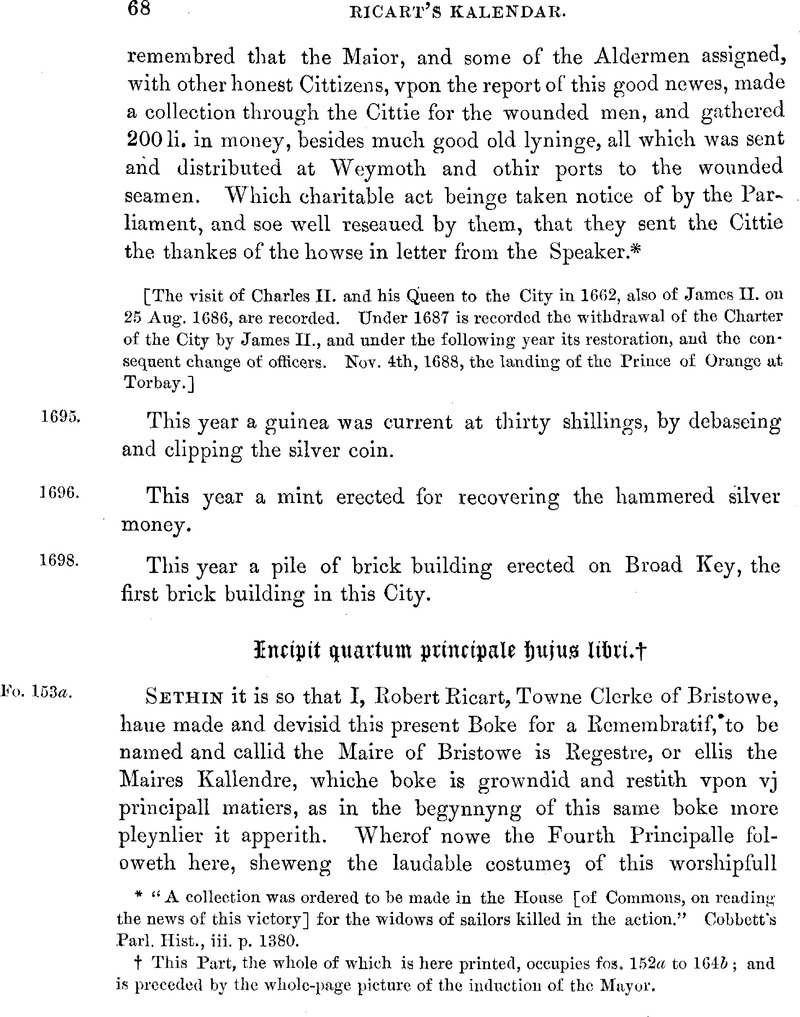No CrossRef data available.
Article contents
Encipit quartum principale hujus libri
Published online by Cambridge University Press: 24 December 2009
Abstract

- Type
- Ricart's Kalendar
- Information
- Camden New Series , Volume 5: The Maire of Bristowe is Kalendar, By Robert Ricart, Town Clerk of Bristol 18 Edward IV. , June 1873 , pp. 68 - 86
- Copyright
- Copyright © Royal Historical Society 1873
References
Page 68 note * “A collection was ordered to be made in the House [of Commons, on reading the news of this victory] for the widows of sailors killed in the action.” Cobbett's Parl. Hist., iii. p. 1380.
Page 68 note † This Part, the whole of which is here printed, occupies fos. 152a to 164b; and is preceded by the whole-page picture of the induction of the Mayor.
Page 71 note * The erased words within brackets [ ] are by a later hand.
Page 72 note * The words between brackets are added in the margin in the original.
Page 72 note † Fo. 154b of the MS. finishes with this paragraph, and here two leaves hare been carefully inserted, on which is written the Mayor's oath in the time of Henry VIII. It recites him as “defender of the Faithe,” &c, and includes all the clauses of the oath given by Ricart (Edw. IV.) but a clause is added (next before that in support of the house of the Kalendars (a), p. 73) in the words enjoined by sec. 6 of the Act 28 Hen. VIII. c. 10, for “extynguysshing the auctoryte of the Busshop of Home.” In the time of Philip and Mary the oath was again corrected; their names and style are inserted instead of those of Henry, which are crossed out; and the fresh clause as to the bishop of Borne, and the old one as to the Kalendars, are struck out. To complete the history of the oath, fo. 195b contains a copy of the oath as taken (according to a side-note) in 1598, 40 Eliz., which resembles that of Edw. IV. but omits the clauses as to Lollardries, the causes of the church, the kalendars, and as to bye-laws of the City, being the portions marked on pp. 73, 74, between brackets. A new clause of supremacy, under the Act 1 Eliz. c. 1, § 9, is added.
Page 73 note * One or two of the words in this line are inserted, and others are erased.
Page 74 note * The words between square brackets have been inserted. See before, p. 72, note †.
Page 74 note † This is added in the margin in a much later hand.
Page 75 note * The “rede booke” here named must mean the yolume known as the “Little Red Book,” some of the early pages of which contain a number of oaths to be taken by the city officers, written in French in the time of Edw. III. The oath of the Town Clerk is as follows (fo. 18). “Saoramentum clerici eommunis. Ceo oyetz vous Maire et bones gentz qe ieo serrey foyal et loyal a nostre seygnur le Rey et a les maire et communaltee de B., et le counseyl del dist nostre seygnur le Rey et de la ville celerey, et loyalment les plez, pledez en la gihald de la diste ville devaunt les distz maire et baillifs par lauys de le Recordour, en roule entray, et nulle fause querele ne meynteyndrey nautry droyt ne destourberey a moun ascient, et la fraunchise, la pecz, custumes, et ordinaunces qe bones sount garderey et defenderey. Et toutz les briefs, comissiones, remembraunces, et totes altres choses tochauntes la diste commun a lyuerez a moun poayr saluement garderey, et altres choses appendaunts a moun office loyalment fray a moun ascient, sy dieux meyd.” The oath of him who seems to have been Clerk to the Counter is on the same page. See after, p. 88.
Page 76 note * A “composition” was a bond or agreement, in these cases establishing a chantry and containing ordinances for its government. (See a very curious “composition” or agreement for the payment of church dues in London in 1457, Arnold's Chronicle of London, p. 71.) The “rede boke” appears again to mean the “Little Red Book” before mentioned; in it are many of these “compositions,” for the most part in Latin, and thence we learn that the dates of their foundations were:— E. le Franceys, 1350; Richard Spicer, 1377; John Stoke, 1385; Walter Frampton, 49 Edw. III. (1376); Edmund Blanket, 1389. Two others contained in the Little Red Book are those of Richard de Welles, in 1333, and Richard White, in 1334. That of Joan Hallewey (for her husband Thomas) is in English: it may serve as a specimen of the others. (L. R. B. fo. 157.)
“This is the composicioun and ordenaunce of Johanne Hallewey, laat wif of Thomas Hallewey, laat burgeis and marchaunt of the towne of Bristow, maad creat and establisshid for the gode reule of a chaunterie laat foundid bi be saide Johanne, as executrice of the testament of the saide Thomas, in the chirche of Allehalwis for euermore, as hit apperith in articles herafter, and y-made the vij day of Junij the yerre of the reygne of our soueraygn lord the kynge Herry the sext after the Conquest xxxj.” The document goes on to appoint a priest to perform chantry services, and gives him a salary and “chambre and mansion” in a new house lately built; the appointment of such priest to be made by the Mayor under seal, the priest to make oath yearly before him to perform his duties in the services. The priest is to find his own “singing breed and wyne.” The Mayor is to assist the procurators (churchwardens) of the church in looking after the rents and property of the chantry, and for this trouble certain stuns are to be paid to the City Officers. (See the case of Canynge's Chantry, after, p. 79.) The procurators to make account of the property at the same time that they account for the “liflood [income] and other thinges” of the church, in presence of the Vicarie “and the worthiest men for the time being of the saide parisch.” Dated 20 Juyn, 31 Hen. VI. (1453). This instrument not only explains the connection of the chantry priests with the mayor, but gives a very interesting glimpse of the management of parish affairs at that date.
Page 78 note * In the “Little Red Book” there are entered the Ordinances of divers crafts of the town, and the following extract from one set of these throws some light on the above paragraph. It has no date, but stands between other ordinances of 21 Hen. VI. and 35 Hen. VI. and was written about the same time. (L. E. B. fos. 148, 149.) “To worschipful sires, Maier, schireve, and godde folke of the commune counsaile of the towne of Bristow, praye mekelich be goode folke of the craftes of iferours, smythes, cotillers, and lokyers of: the said towne,” that they will “gracyouselich grawnty to be seyd goode ffolke” certain articles and ordinances following, among which is.:—
“And vppon thees ordynaunces and artycles be gode folke of be seid iiij craftes preyeb bat fowre maystres mow be chose by be seid craftes everich yere, for to surveye the defawtes of be seid craftes, and y-swore to fore the Mayer, trwlych to present to the mayer and to his mynystres of be seid towne alle the defawtes bat they mow fynde.
“Reseruyng alle tyme to be mayor of Bristow and to be consayle of be towne power to correcte, to pynyssche, amercye, and redresse, as wel be maystres and alle ober persons of the seyd fowre craftes, everych after her deservyng and trespasse, as be case askyth.”
Page 79 note * So in the original, but evidently au error for Proctors, the contraction of Procurators (or churchwardens). Canynges' Chantries were but a very few years old in Ricart's time ; he founded them in 7 Ed. IV. 1467. The principal documents concerning them are contained in the “Great Red Book,” fol. 288 to 296.
Page 79 note † See, before, note on p. 77.
Page 81 note * This account should be compared with a very curious Account of the Sheriffs of Bristol with the Exchequer, which includes some of these items ; a transcript of which is contained in the British Museum, Add. MS. 24,785, fos. 10—21. It is fuller than that in Barrett, p. 123. See also the record quoted before, p. 50, note.
Page 83 note * See after, p. 94.
Page 83 note † An ordinance temp. Hen. VIII. says that the Aleconner “shall every shifting day in the year boldly go into the houses of the common brewers, before their shifting of every of their ale, and there shall taste the same, &e.”
Page 84 note * A carnok or crannock held four bushels. From a comparison of Harl. MS. 368, fo. 11, with this ordinance it appears that these must have been true coals, in the modern sense. A Petition (without date, but seems to be of the time of James I.) was made by the Mayor and Commonalty of Bristol to the Privy Council, in which it is stated that the poor “doe use only to burne Stone Coale alias Sea Coale in their howses, which Coale they have had from Kinges Woodde and other places,” paying not above 3½d. per bushel, which was a great benefit as wood was very scarce. (Compare the last ordinance above, as to wood.) Complaint is made that one Arthur Player has engrossed “all the Coale Pyttes,” whereby the price is enhanced, and “hath cutte and diminished the sackes of such as vse to bring Coale to the said Cytie.” In 1606 an ordinance was made by the City as to the sale and measure of “stone coal.” MS. Brit. Mus. Egerton, 2044, f. 12. Before this time, in 1506, a letter to Sir Wm. Cecil says that “at Bristoll all manner of fewell is good cheap, a myne of sea cole being allso within iiijor myle of Brystoll.” State Papers Domestic, vol. 40, f. 17.
Page 84 note † “Residence to be kept bi the Maire at the Tolsill.” Side note in MS. See note before, p. 53.
Page 86 note * This proclamation was directed against the abuse of the popular sports which obtained during the festivities of Christmas. The Lord of Misrule, “beginning his rule at All-hallow eve, continued the same till the morrow after the Feast of the Purification, commonly called Candlemas Day, in which space there were fine and subtle disguisings, masks, and mummeries” (Strype's Stow's Survey, Bk. i. p. 252); and mumming with visors, “cloce visaged,” was especially a Christmas custom; sometimes turned to evil purposes. See Brand's Pop. Antiquities, i. p. 356. Similarproclamations were made in other towns on like occasions, e. g. York and Coventry. Hone's Ancient Mysteries, p. 211; T. Sharp's Coventry Mysteries, p. 169, note.


